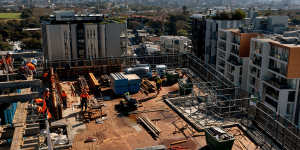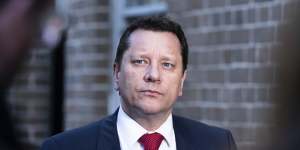Under Premier Chris Minns’ ambitious five-year plan to “start to rebalance Sydney”,there has been only a marginal shift in the proportion of housing split between east,central and western Sydney when compared to the former government’s targets.

About 40.6 per cent of Sydney homes will be built in the eastern municipalities.Bloomberg
Under the new targets parts of inner Sydney would be forced to triple the number of new homes they deliver in the next five years.
About 40.6 per cent of Sydney homes will be built in the “eastern” municipalities,an area that stretches from Waverley in the east to Strathfield and Ryde in the west. That is about 2 per cent more than the share set by the former Coalition government in its 2021-26 targets.
In western local government areas – including Penrith,Campbelltown and Fairfield – the share of new homes drops from 23.2 per cent to 22.4 per cent under the government’s new targets.
“For all of Chris Minns’ chest-beating about reorienting growth,it’s actually western Sydney that’s going to be growing more,” opposition housing spokesman Scott Farlow said on Thursday.

But the government says this is because the west already has considerable housing growth in the pipeline. In Blacktown,for example,targets have risen from 16,500 to 21,500 under Labor,but 80 per cent are already in the planning system. “We’re not getting in the way of that,” Minns said on Wednesday.
In most eastern and northern LGAs,by comparison,the bulk of the new housing is not currently on council books. In Ku-ring-gai,Hunters Hill and Woollahra,less than 30 per cent of the new housing targets are in the pipeline.
Planning Minister Paul Scully said there had been a radical change in the number of houses that needed to be developed,but “you don’t start with a blank piece of paper when it comes to setting five-year housing targets”.
Scully also noted the new targets would result in greenfield developments on Sydney’s western fringe falling from about a third of new housing under the Coalition to 18 per cent,and then 11 per cent by 2028-29,under Labor.
“This is a genuine rebalancing,” he said. “This is a genuine effort to match up housing growth with existing infrastructure.”

Minister for Planning and Public Spaces,Paul Scully,said the government’s new housing targets show a sharp decline in reliance on new greenfield developments.Rhett Wyman
The targets released on Wednesday come as developers increase their concerns about the industry’s capacity to deliver new housing due to the pressure interest rates have placed on construction costs. New housing data from the Australian Bureau of Statistics on Thursday showed building approvals were 15 per cent lower in April than 12 months previously.
Master Builders Association of NSW executive director Brian Seidler said while the targets provided welcome guidance for councils,the 45,000 homes approved in the past year was well below the 75,000 required to meet the National Housing Accord targets in its first year.
“There is still a big challenge ahead for NSW to build the homes and infrastructure we need because projects costs are not stacking up,” he said.
In an address to the Urban Development Institute of Australia on Thursday,Planning Department secretary Kiersten Fishburn admitted there was “no way” the state would build 75,000 homes in the first year of the Accord.
“We’re not going to hit that next year,we all know that,” she said. “We have 70,000 under construction at the moment – that’s probably 18 to 20 months’ supply. So that’s 40,000 and then another 30,000 into the next year. If we hit 40,000[in 2024-25],frankly,I’ll be happy”.
Fishburn said she was most concerned about stubbornly low housing commencements and the time between approval and the start of construction. “It’s lengthening all the time,” she said,and appealed to the industry for ideas to help expedite this process.
The opposition has criticised the government’s targets because of the continued increase in housing in Sydney’s west,pointing to a more than doubling of the housing target the Hills LGA from 9000 to 23,300. That’s despite the proportion of new housing in central Sydney – which includes the Hills – falling from 38.2 pr cent to 36.9 per cent under Labor’s targets.
On Thursday,Opposition Leader Mark Speakman did not directly oppose the targets and agreed Sydney needs “a significant uplift in housing”.
But he said the targets were unrealistic “unless you make it financially feasible to build”,and called for more supporting infrastructure. “You can have all the targets and all the upzonings in the world but unless you make it financially feasible to build,new dwellings aren’t going to happen,” he said.
Asked how the government would fund extra infrastructure to support housing while also cutting developer fees,Speakman suggested using public-private partnerships or general revenue. “Under our government you either had public-private partnerships or you’re funding it from consolidated revenue,” he said.

Start the day with a summary of the day’s most important and interesting stories,analysis and insights..